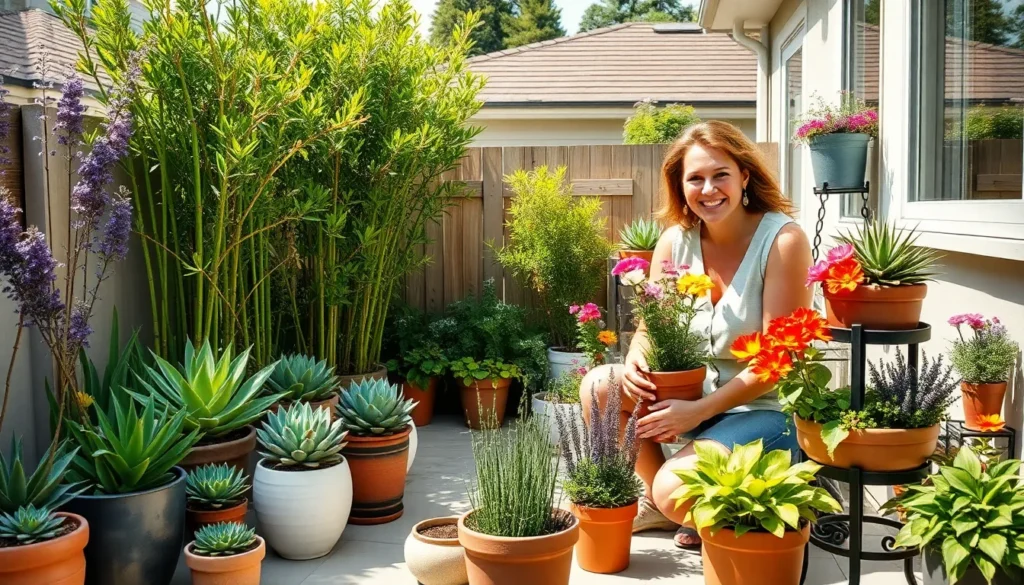We’ve all dreamed of transforming our patios into stunning outdoor sanctuaries that rival the most beautiful gardens. Whether you’re working with a sprawling deck or a cozy balcony, the right plant choices can completely revolutionize your outdoor space and create an inviting retreat you’ll never want to leave.
The secret lies in selecting plants that not only thrive in your exact climate but also complement your lifestyle and maintenance preferences. From vibrant flowering displays that burst with color to elegant foliage that provides natural privacy screens, we’ll show you how to curate the perfect plant palette for your unique space.
Ready to discover the outdoor patio plant ideas that’ll make your neighbors green with envy? We’re about to jump into proven strategies and creative combinations that work beautifully across different climates, budgets, and skill levels – ensuring your patio becomes the outdoor oasis you’ve always envisioned.
Choose Low-Maintenance Succulents for Sunny Patios
Succulents offer the perfect solution for busy homeowners who want stunning patio plants without constant watering and care. These resilient beauties store water in their thick leaves and stems, making them ideal for hot, sunny locations where other plants might struggle.
Colorful Echeveria Varieties
Echeveria rosettes create stunning focal points with their rainbow of colors ranging from blue-green to deep purple and coral pink. We recommend ‘Blue Curls’ for its distinctive ruffled edges and powder blue coloring that intensifies in bright sunlight. ‘Black Prince’ develops dramatic burgundy to nearly black foliage that contrasts beautifully with lighter colored containers.
These compact succulents typically grow 4-6 inches wide and produce tall flower spikes in spring with bell-shaped blooms in shades of pink, red, or yellow. Echeveria thrives in temperatures between 65-80°F and requires well-draining soil to prevent root rot. We suggest grouping different varieties together in large containers to create eye-catching succulent gardens that require watering only once every 7-10 days.
Drought-Tolerant Jade Plants
Jade plants serve as living sculptures with their thick, glossy green leaves and tree-like structure that develops over time. Crassula ovata can grow up to 3 feet tall in containers and produces small white or pink star-shaped flowers during winter months. These plants store water so efficiently they can survive weeks without irrigation, making them perfect for vacation-friendly patio displays.
We’ve found jade plants respond well to bright morning sun with afternoon shade protection in extremely hot climates. Their thick stems become more pronounced with age, creating natural bonsai-like forms that add architectural interest to any patio corner. Propagation is remarkably easy since fallen leaves often root themselves in nearby soil, giving you new plants to expand your collection or share with neighbors.
Architectural Agave Species
Agave plants provide dramatic structural elements with their sword-like leaves arranged in perfect geometric rosettes. Century plants (Agave americana) can reach 6 feet across in large containers, while smaller varieties like Agave parryi stay compact at 2-3 feet wide. Most species feature sharp terminal spines and serrated leaf edges that create striking silhouettes against patio walls or fencing.
These desert natives require minimal water once established and actually prefer neglect over frequent attention. We recommend choosing cold-hardy varieties like Agave havardiana or Agave neomexicana if you experience occasional freezing temperatures. Their blue-gray to green coloration provides year-round interest, and many species produce spectacular 10-20 foot flower stalks after 10-30 years of growth, creating once-in-a-lifetime blooming events.
Create Privacy with Tall Container Plants
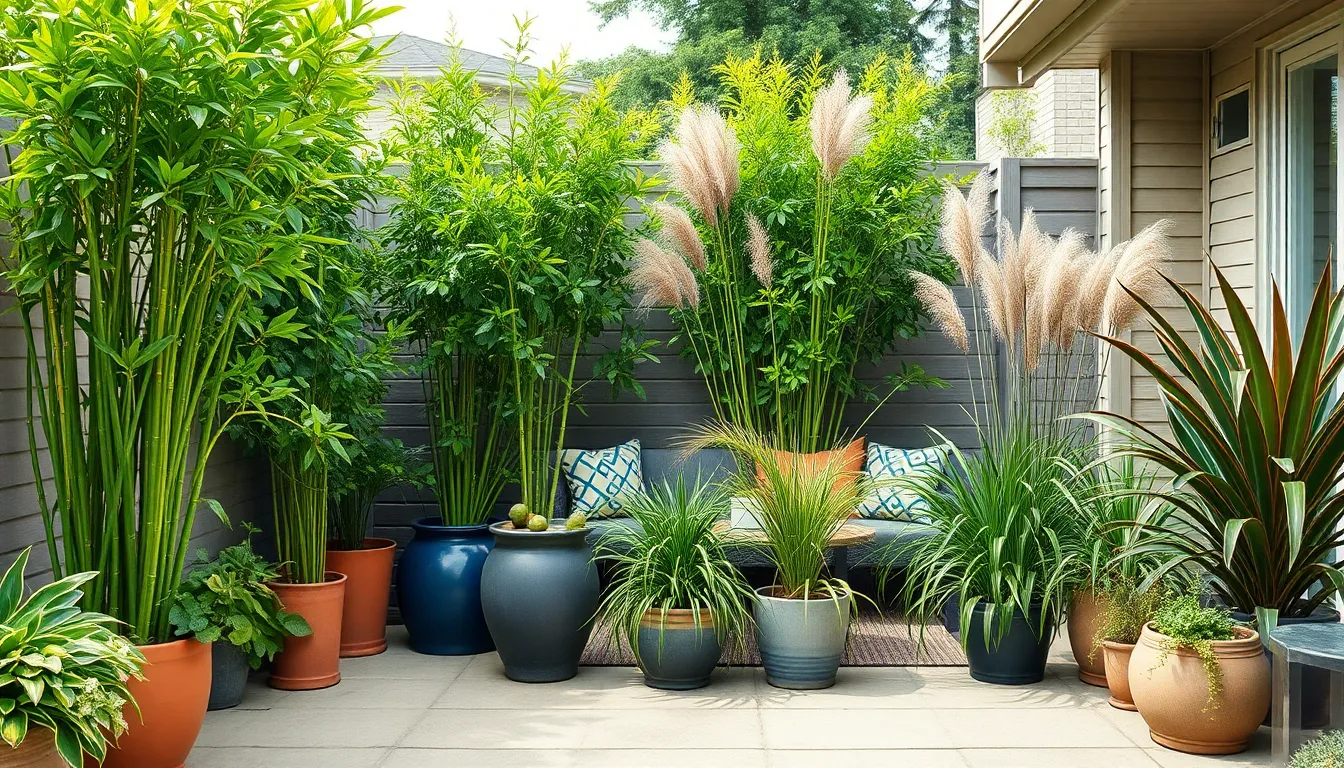
Tall container plants offer the perfect solution for creating natural privacy screens while maintaining flexibility in your patio design. We can easily move these living barriers to adjust our outdoor space as needed.
Bamboo Screen Answers
Bamboo plants excel at creating dense, tropical privacy barriers that grow quickly and filter light beautifully. We recommend choosing clumping bamboo varieties like fountain bamboo or Buddha’s belly bamboo to avoid invasive spread. Container grown bamboo reaches impressive heights of 8-12 feet within just two growing seasons.
Growing bamboo in large containers allows us to position these natural screens exactly where we need privacy most. These fast growing plants create a lush green wall that blocks unwanted views from neighbors while adding exotic appeal to our patio. We can select from running or clumping varieties depending on our space requirements and maintenance preferences.
Ornamental Grass Barriers
Ornamental grasses provide elegant privacy answers that add graceful movement and texture to our patio environment. Pampas grass creates stunning 6-8 foot tall screens with feathery plumes that sway gently in the breeze. Feather reed grass offers a more compact option at 4-5 feet tall with upright growth habits perfect for smaller patios.
We can cluster multiple pots of ornamental grasses to create dense privacy barriers that soften harsh architectural lines. These low maintenance plants require minimal watering once established and provide year round interest with their changing seasonal colors. Miscanthus varieties offer particularly striking options with their tall stems and flowing seed heads that create natural privacy walls.
Evergreen Shrub Options
Evergreen shrubs deliver consistent year round privacy coverage that maintains its screening power through all seasons. Boxwood varieties grow well in containers and can be pruned into formal shapes or left natural for a more relaxed privacy barrier. Holly shrubs provide dense foliage with the added benefit of colorful berries and glossy leaves.
Arborvitae specimens work exceptionally well as container privacy plants, reaching 6-10 feet tall while maintaining narrow profiles perfect for tight patio spaces. We can choose from dwarf varieties like ‘Emerald Green’ or larger options like ‘Green Giant’ depending on our exact privacy needs. These reliable evergreens tolerate various light conditions and provide instant privacy impact when planted in substantial containers.
Add Fragrance with Aromatic Herb Gardens
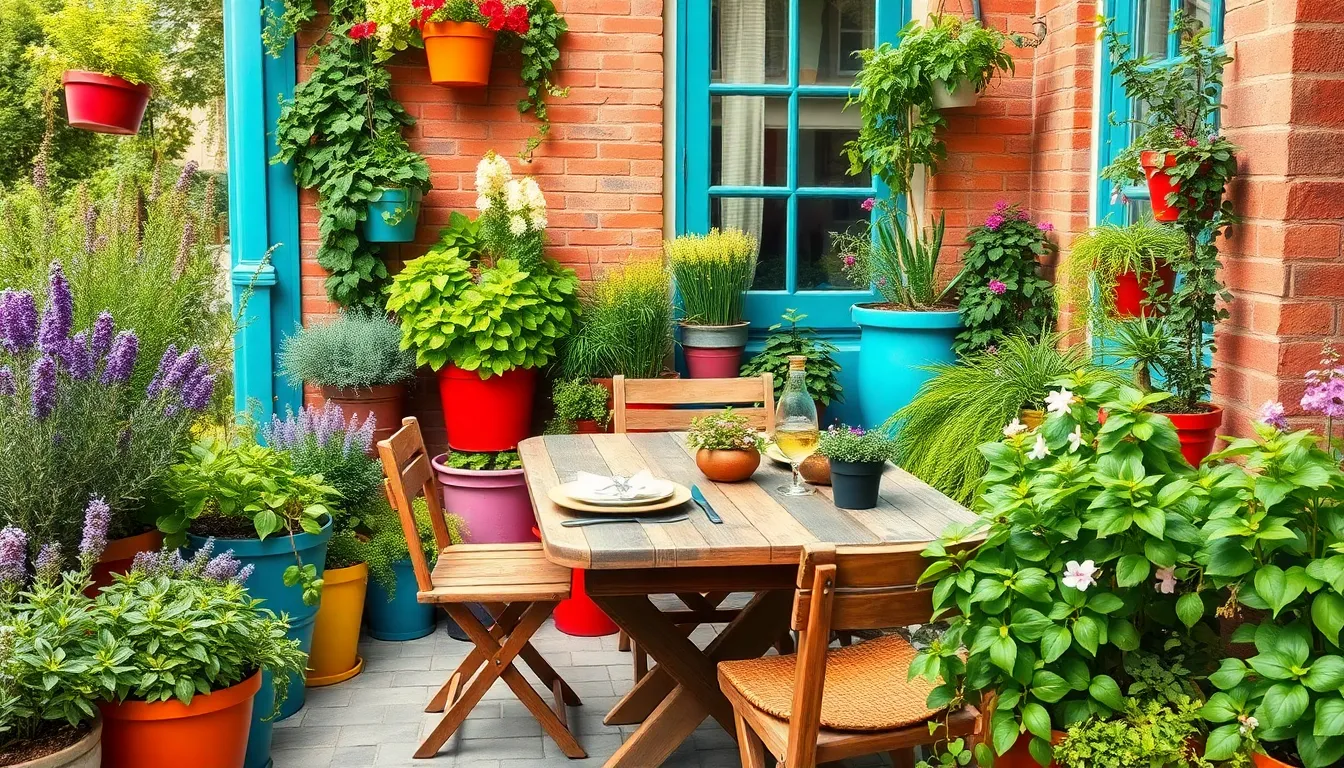
Transforming your patio into an aromatic sanctuary becomes effortless when you incorporate fragrant herbs that delight the senses. We’ll explore strategic combinations that maximize both scent and visual appeal while serving practical purposes.
Mediterranean Herb Combinations
Mediterranean herbs like lavender, rosemary, oregano, and thyme create the perfect aromatic blend for sunny patio conditions. These heat-tolerant perennials thrive together because they share similar water and sunlight requirements. Tuscan rosemary provides year-round fragrance with its needle-like foliage, while lavender adds stunning purple blooms and therapeutic scent.
Russian sage complements these classics by emitting a strong fragrance when its leaves are crushed, making it ideal for compact spaces. Grouping these herbs in matching containers or raised beds recreates an authentic Mediterranean garden atmosphere. We recommend placing them near outdoor dining areas where their combined fragrances enhance the dining experience.
Culinary Herb Container Gardens
Container gardens featuring culinary herbs deliver both beauty and kitchen convenience in one perfect package. Basil, cilantro, chives, marjoram, mint, parsley, oregano, and sage flourish in well-drained potting soil with consistent watering. These cook-friendly herbs can be harvested easily for fresh seasoning throughout the growing season.
Creating visual interest involves mixing herbs of different heights and leaf textures within your container arrangement. Using tiered plant stands or ladders maximizes vertical space while keeping herbs accessible for harvesting. We suggest positioning these containers near your kitchen door or outdoor cooking area for ultimate convenience.
Pest-Repelling Fragrant Plants
Aromatic herbs naturally deter unwanted insects while filling your patio with delightful scents. Rosemary, lavender, mint, and sage effectively repel mosquitoes, aphids, and other garden pests without chemical interventions. These dual-purpose plants create a more comfortable outdoor environment for entertaining and relaxation.
Beyond herbs, fragrant flowers like jasmine, gardenia, and heliotrope provide sweet evening scents while attracting beneficial pollinators. We recommend strategically placing these pest-repelling plants around seating areas and entrances where their protective benefits are most needed. Their natural pest control properties reduce maintenance while improving your patio’s overall ambiance.
Incorporate Seasonal Flowering Plants for Year-Round Color
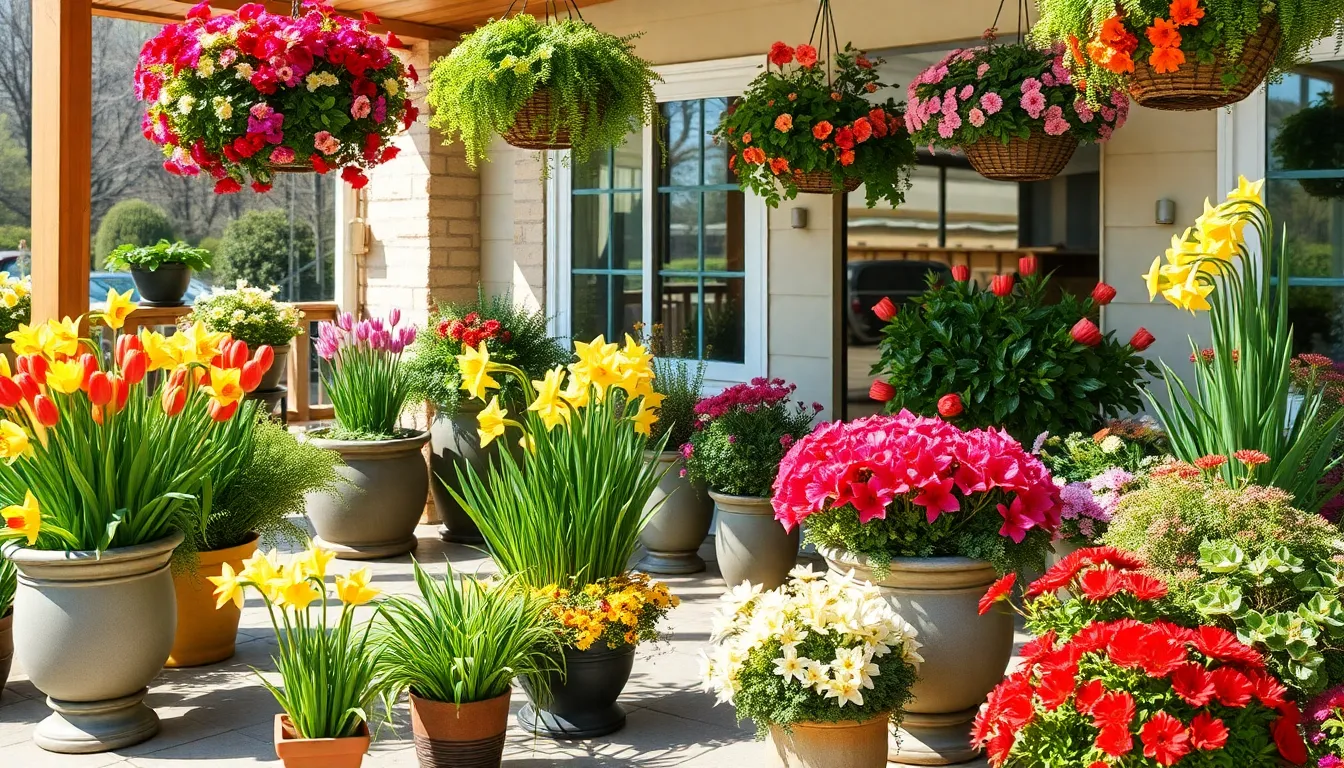
Seasonal flowering plants create ever-changing color displays that evolve throughout the year. We’ll explore strategic plant selections that ensure continuous blooms from spring through fall.
Spring Bulb Displays
Tulips and daffodils brighten patios after winter’s dormancy with cheerful colors that herald the growing season. We recommend planting these classic spring bulbs in containers for flexible patio displays that can be moved as needed. Combining them with early foliage plants creates fullness and visual depth during the spring transition period.
Crocus and hyacinths provide additional early season color alongside your primary bulb displays. These smaller bulbs bloom early in the season and offer vibrant splashes of purple, white, and yellow. We suggest clustering different varieties together in containers to create stunning spring arrangements that maximize visual impact.
Summer Annual Combinations
Calibrachoa delivers continuous blooms in hot pink, deep purple, and bright yellow without requiring deadheading maintenance. This trailing annual thrives in full sun conditions and creates cascading displays perfect for hanging baskets. We love how its vibrant colors maintain intensity throughout the hottest summer months.
Fuchsias and verbena excel in hanging baskets and containers where their long-lasting blooms create dramatic focal points. These plants offer extended flowering periods during warmer months and attract beneficial pollinators. We recommend combining them with trailing plants for layered container arrangements.
Boston fern adds lush green texture that provides cooling visual relief on summer patios. While primarily a foliage plant, it thrives in part sun conditions and complements flowering companions beautifully. We use this fern to create depth and balance in our summer container combinations.
Rex begonia transforms shaded patio areas with dramatic foliage patterns in silver, burgundy, and green. These plants add sophisticated interest without requiring full sun exposure and complement flowering plants perfectly. We position them in partially shaded spots where their colorful leaves become stunning focal points.
Fall Chrysanthemum Arrangements
Chrysanthemums offer the quintessential fall color palette with rich gold, burgundy, and orange blooms. These hardy perennials provide the final burst of autumnal color before winter dormancy sets in. We arrange different mum varieties in containers to create seasonal displays that celebrate harvest time aesthetics and work exceptionally well on patios where their compact growth habit fits perfectly in various pot sizes.
Design Vertical Gardens for Small Patio Spaces
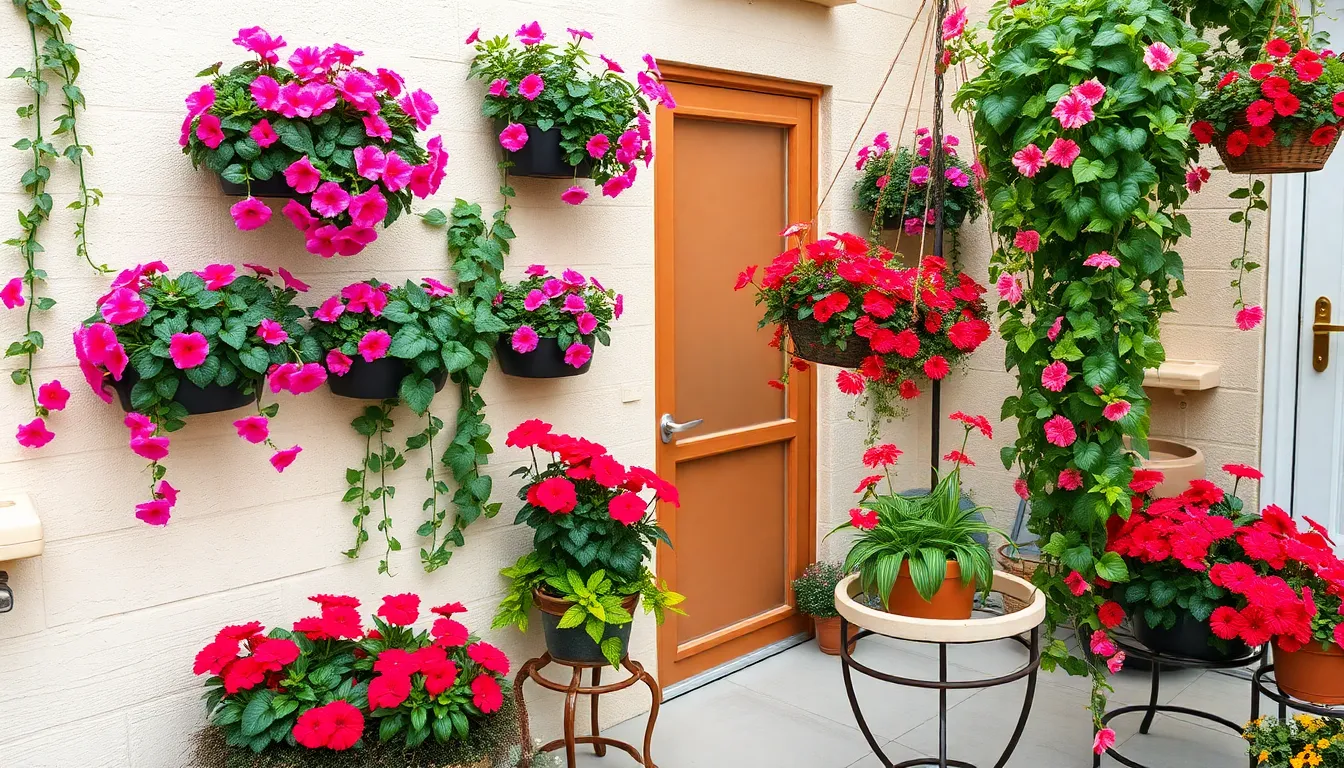
Maximizing your patio’s growing potential becomes effortless when we use vertical space for stunning plant displays. Creating upward gardens transforms even the smallest outdoor areas into lush sanctuaries.
Wall-Mounted Planter Systems
Wall-mounted planters offer the perfect solution for maximizing floor space while creating eye-catching displays. Sweet Alyssum thrives in these systems with its delicate annual blooms that spill fragrant colors in white, pink, or purple varieties. English Ivy creates a charming cottage vibe when grown in wall-mounted containers, providing cascading greenery that softens hard surfaces.
Securing planters properly ensures long-lasting installations that can support various plant weights. Drainage becomes crucial for wall systems since excess water needs proper channels to prevent damage. Lemongrass and rosemary work exceptionally well in wall planters, adding practical mosquito-repelling benefits while contributing fresh herbs for cooking.
Tiered Plant Stand Arrangements
Tiered plant stands create ever-changing displays by showcasing multiple plants in compact arrangements with layered visual interest. Red Petunia provides vibrant blooms that catch attention on upper tiers, while Pink Lantana offers continuous color throughout growing seasons. Verbena Bonariensis adds height and texture with its delicate purple flowers that attract beneficial pollinators.
Arranging plants by size creates natural flow from larger specimens on bottom tiers to smaller varieties above. Bloom timing coordination ensures continuous color as different plants peak at various times throughout the season. Compact hydrangeas work beautifully on sturdy stands, providing substantial foliage and impressive flower displays that anchor tiered arrangements.
Hanging Basket Combinations
Hanging baskets bring plants to eye level while softening patio edges with graceful trailing elements. Black-Eyed Susan Vine covers impressive heights over 6 feet during summer months, creating natural privacy screens with fast-growing coverage. Vineyard-style plants like this vine offer both beauty and functional screening for intimate patio spaces.
Cottage-favorite English Ivy trails beautifully from elevated baskets, creating lush cascading effects that enhance vertical garden designs. Sweet Alyssum adds honey-scented charm with its delicate flowers that attract beneficial pollinators to outdoor spaces. Mixing flowering plants with trailing greenery creates balanced compositions that provide both color and texture in hanging displays.
| Setup Type | Recommended Plants | Key Benefits |
|---|---|---|
| Wall-Mounted Planters | Sweet Alyssum, English Ivy, Lemongrass, Rosemary | Space-saving, mosquito repelling, culinary herbs |
| Tiered Plant Stands | Red Petunia, Pink Lantana, Verbena Bonariensis, Hydrangea | Layered color, continuous blooms, pollinator attraction |
| Hanging Baskets | Black-Eyed Susan Vine, Sweet Alyssum, English Ivy | Eye-level beauty, privacy screening, cascading effects |
Select Weather-Resistant Plant Varieties
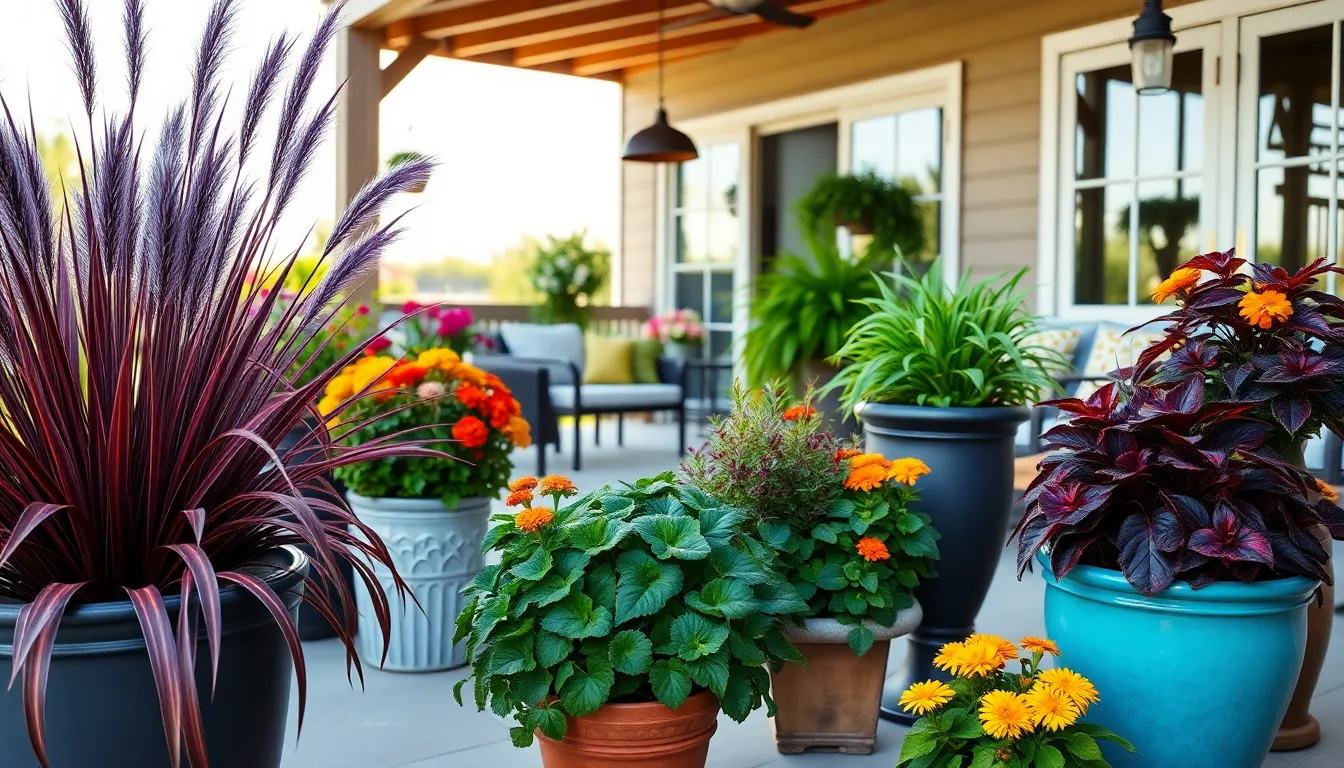
Choosing plants that can withstand your local weather conditions ensures your patio remains beautiful year-round while minimizing maintenance requirements. Weather resistant varieties adapt to temperature fluctuations, wind exposure, and varying moisture levels without losing their appeal.
Wind-Tolerant Plant Options
Ornamental grasses excel in windy patio environments due to their flexible stems and strong root systems. Purple fountain grass stands out as our top recommendation, featuring burgundy foliage and plumed flowers that bend gracefully with breezes rather than breaking. This warm season grass grows more compactly in containers while maintaining its drought tolerance and minimal care requirements.
Plants with sturdy root systems and flexible growth habits naturally resist wind damage better than rigid specimens. We’ve found that grasses create beautiful movement in windy conditions rather than appearing damaged or stressed. Consider dividing purple fountain grass in spring to maintain its compact container size and vigorous growth.
Heat-Resistant Patio Plants
Tropical and drought adapted plants thrive in scorching summer conditions while maintaining their vibrant appearance. Purple fountain grass handles hot weather exceptionally well, requiring minimal water once established in containers. Red mandevilla vines produce bright blooms throughout summer heat, preferring full sun with some afternoon shade in extremely hot climates.
Marigolds deliver reliable color from spring until the first frost, thriving in full sun conditions that would stress other flowering plants. False heather (Cuphea hyssopifolia) grows rapidly with proper feeding and loves sunny locations, though we recommend providing afternoon shade in areas with intense heat. These heat lovers continue blooming when temperatures soar, making them perfect for south facing patios.
Cold-Hardy Container Varieties
Perennial plants that survive freezing temperatures return year after year, providing excellent value for container gardening investments. Heucheras (coral bells) offer year-round visual interest with their attractive foliage, remaining hardy in zones 3-8 across most climates. We particularly appreciate their ability to maintain color even during dormant winter months.
| Plant Variety | Cold Hardiness Zones | Special Features |
|---|---|---|
| Heucheras (Coral Bells) | 3-8 | Year-round foliage interest |
| Golden Creeping Jenny | 4-8 | Cascades over pot edges |
| Hostas | 3-9 | Shade tolerant, returns annually |
| Hardy Ferns | 3-10 | Thrives in moist, shaded conditions |
Golden creeping jenny cascades beautifully over container edges while tolerating partial shade and surviving winters in zones 4-8. Hostas adapt perfectly to shaded, cooler patio spots and return reliably each spring if their roots survive winter dormancy. Hardy ferns thrive in shade with consistent moisture, and we can move their containers indoors during extreme cold snaps for added protection.
Choose Appropriate Container Sizes and Materials
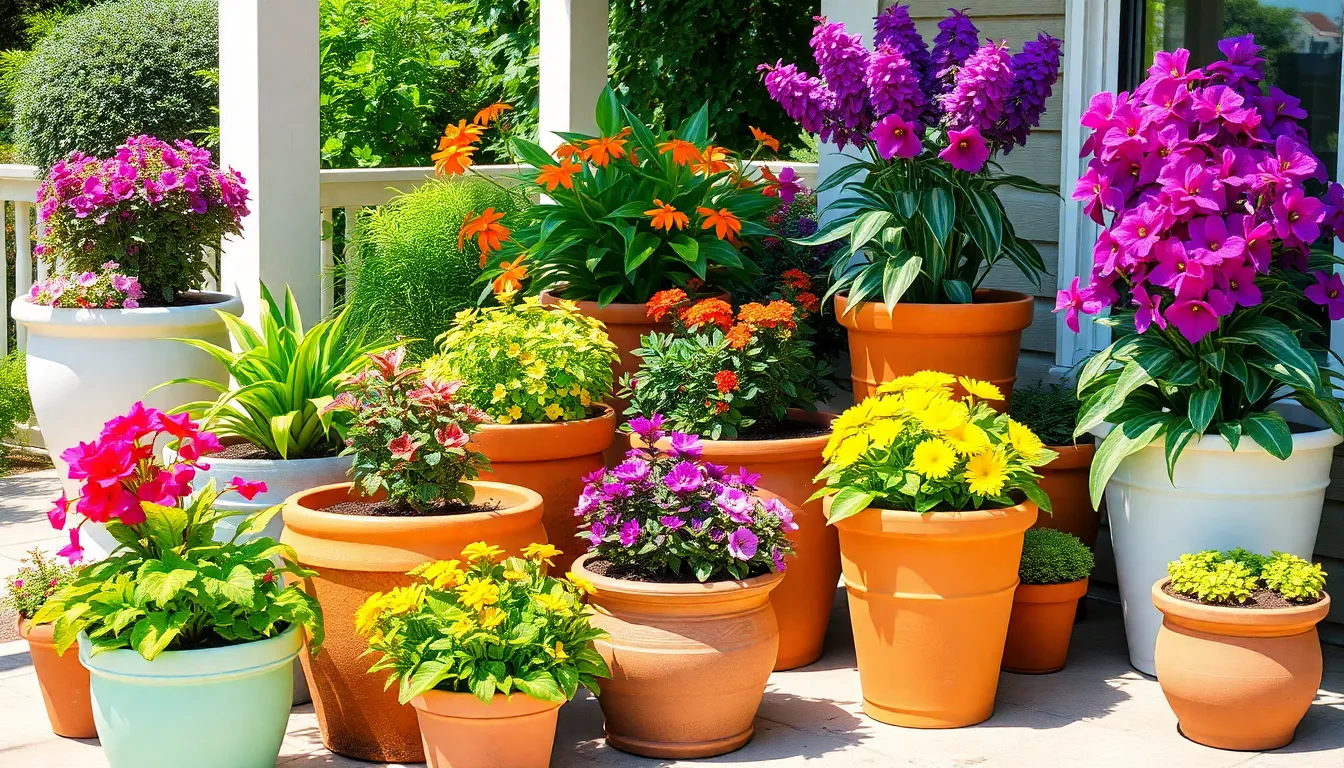
Selecting the right containers transforms your weather-resistant plant varieties into thriving patio displays. We’ll guide you through essential considerations that ensure your outdoor plants flourish in their new homes.
Drainage Requirements for Outdoor Plants
Proper drainage prevents the root rot that destroys even the most resilient plants. Containers must include drainage holes to allow excess water to escape effectively. We recommend checking that each pot has multiple holes rather than just one central opening.
Adding a layer of gravel at the bottom enhances water flow and prevents soil from blocking drainage holes. This simple step protects your cold-hardy container varieties like Heucheras and hostas from waterlogged conditions. Elevated pot feet or plant stands improve drainage further by lifting containers off patio surfaces.
Drainage becomes even more critical during heavy rains when your heat-resistant plants like marigolds need protection from oversaturated soil. We suggest monitoring water levels during the first few weeks to ensure your containers drain properly.
Weather-Resistant Pot Materials
Outdoor containers face constant exposure to sun, rain, and temperature fluctuations that can destroy inferior materials. Fiberglass and resin pots offer exceptional durability while remaining lightweight for easy rearrangement. These materials resist cracking in freezing conditions and won’t degrade under UV exposure.
Plastic containers provide affordability and moisture retention but may become brittle after prolonged sun exposure. We recommend high-quality UV-resistant plastic for better longevity. Ceramic and glazed pots create attractive displays but require protection from freezing temperatures to prevent cracking.
Terracotta pots breathe naturally and suit Mediterranean herbs perfectly, though they dry out quickly and need winter protection. Metal containers heat up rapidly in summer sun, potentially damaging plant roots unless properly insulated.
| Material | Durability | Weight | Weather Resistance | Best For |
|---|---|---|---|---|
| Fiberglass/Resin | High | Light | Excellent | All climates |
| Plastic | Medium | Light | Good | Budget-friendly options |
| Ceramic/Glazed | High | Heavy | Fair | Protected areas |
| Terracotta | Medium | Heavy | Poor | Herbs, seasonal plants |
Size Guidelines for Plant Growth
Container size directly impacts your plants’ ability to develop healthy root systems and reach their full potential. Herbs require 4-12 inches depending on the species, with thyme needing 4-6 inches while rosemary demands 8-12 inches for proper growth.
Vegetables need 6-16 inches with exact requirements based on their growth patterns. Root vegetables like carrots require 10-12 inches of depth, while sprawling plants like zucchini need 16+ inch wide containers. Tomatoes thrive in 12-16 inch pots equivalent to 5+ gallons for adequate root space.
Decorative plants range from 6 inches for compact varieties like pothos up to 14+ inches for statement plants like fiddle leaf figs. Starting seedlings in 2-3 inch pots before transitioning to 4-inch containers develops stronger root systems.
We recommend choosing containers slightly larger than current needs to accommodate growth, especially for perennial plants that’ll return each season. This approach reduces repotting frequency and supports long-term plant health.
Plan Strategic Plant Placement for Optimal Growth
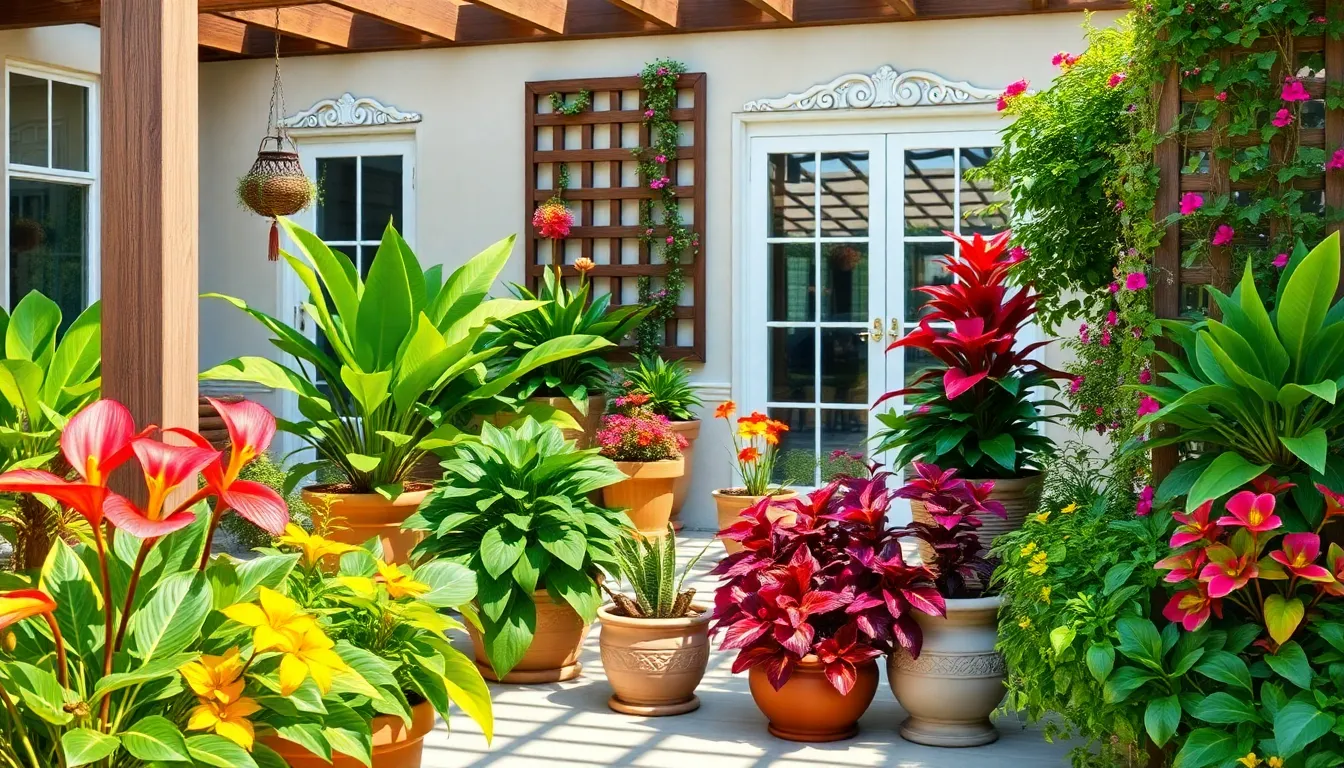
After selecting your containers and materials, we need to focus on strategic placement that maximizes both plant health and visual appeal. Proper positioning considers sunlight patterns, wind exposure, and design principles to create thriving outdoor displays.
Sun and Shade Requirements
Assess your patio’s light patterns throughout the day to determine which plants will flourish in each location. Sunny patios benefit from tropical varieties like Croton Petra and vibrant Sunpatiens, which thrive in direct sunlight and provide bold colors and lush foliage.
Position heat-loving plants like English Lavender in areas receiving full sun exposure, as these herbaceous varieties require good air circulation and bright light for optimal flowering. Partial shade areas work perfectly for Fuchsia and Begonias, which tolerate some sun but also perform excellently in filtered light conditions.
Consider the seasonal changes in sun patterns when planning your layout, as shadows shift throughout the year and affect plant performance. Document your patio’s light exposure at different times to ensure each plant receives its preferred amount of sunlight for healthy growth.
Wind Protection Considerations
Evaluate your patio’s exposure to prevailing winds, which can stress plants and cause physical damage to delicate foliage. Strategic placement involves positioning sturdier plants or small ornamental trees like magnolias as natural windbreakers to protect more fragile specimens.
Arrange containers in clusters to create microclimates that shield sensitive plants from direct wind paths. Install screens or lattice structures that climbing plants like Star Jasmine can use, providing both wind protection and vertical growing opportunities.
Group taller plants on the windward side of your patio to deflect harsh breezes away from delicate flowers and trailing varieties. Use the natural architecture of your space, including walls and railings, to create protected zones where wind-sensitive plants can thrive.
Visual Balance and Design Flow
Create compelling compositions using the “thriller, filler, spiller” principle throughout your patio arrangement. Thriller plants like Canna lilies provide dramatic height and serve as focal points, while filler varieties such as Sunpatiens and Coleus add volume and continuous color.
Incorporate spiller plants like Sweet Potato Vine and Creeping Jenny to soften container edges and create flowing transitions between different plant groupings. Layer plants of varying heights, textures, and colors to maintain visual interest while avoiding a cluttered appearance.
Repeat key colors and plant types strategically around your patio to establish design continuity that guides the eye smoothly through the space. Balance bold contrasts, such as the bright chartreuse of Creeping Jenny against deep purple Sweet Potato Vine, to create ever-changing visual appeal without overwhelming the overall composition.
Conclusion
Creating your perfect patio garden doesn’t have to be overwhelming when you have the right guidance. We’ve covered everything from drought-tolerant succulents to privacy-creating bamboo and aromatic herb collections that’ll transform your outdoor space into a personal retreat.
The key to success lies in matching plants to your exact conditions and maintenance preferences. Whether you’re working with a compact balcony or spacious deck remember that proper container selection and strategic placement make all the difference.
Your patio garden should reflect your lifestyle and bring you joy throughout the seasons. Start small with a few carefully chosen plants and expand your collection as you gain confidence. With these proven strategies you’re well-equipped to create an outdoor sanctuary that’ll be the envy of your neighborhood.
Frequently Asked Questions
What are the best low-maintenance plants for sunny patios?
Succulents are ideal for sunny patios due to their resilience and minimal care requirements. Echeveria varieties offer vibrant colors and compact growth, while jade plants provide drought tolerance and sculptural form. Architectural agave species add dramatic structure and require little water once established, making them perfect for busy homeowners seeking beautiful, low-maintenance outdoor spaces.
How can I create privacy on my patio using container plants?
Tall container plants offer excellent privacy solutions. Bamboo, particularly clumping varieties like fountain bamboo, creates natural screens with quick growth. Ornamental grasses such as pampas grass and feather reed grass provide elegant movement and texture. Evergreen shrubs like boxwood, holly, and arborvitae offer year-round privacy with various heights and maintenance levels to suit different needs.
What herbs work best for patio container gardens?
Mediterranean herbs thrive in patio containers and sunny conditions. Lavender, rosemary, oregano, and thyme provide delightful scents and culinary uses. Basil, cilantro, and mint are excellent for cooking and easy harvesting. Many aromatic herbs like rosemary and lavender also naturally repel insects while enhancing your patio’s ambiance and creating a sensory-rich outdoor environment.
How can I ensure year-round color on my patio?
Plan seasonal plantings for continuous color. Spring bulbs like tulips, daffodils, crocus, and hyacinths bring cheerful early colors. Summer annuals such as calibrachoa, fuchsias, and verbena provide continuous blooms. Fall chrysanthemums offer rich autumn colors. Container planting allows flexibility to rotate seasonal displays and maintain vibrant patio appeal throughout the year.
What are the best vertical gardening solutions for small patios?
Maximize small spaces with wall-mounted planters, tiered plant stands, and hanging baskets. Wall planters save floor space and create eye-catching displays with plants like Sweet Alyssum and English Ivy. Tiered stands showcase multiple plants with layered visual interest. Hanging baskets add beauty at eye level while providing cascading effects and natural privacy screens.
How do I choose weather-resistant plants for my patio?
Select plants suited to your local conditions. For windy areas, choose wind-tolerant varieties like purple fountain grass. In hot climates, opt for heat-resistant plants such as red mandevilla vines and marigolds. For cold regions, select hardy container varieties like Heucheras, golden creeping jenny, hostas, and hardy ferns that return annually and withstand winter conditions.
What container requirements should I consider for patio plants?
Proper drainage is essential to prevent root rot. Choose containers with multiple drainage holes and add gravel for enhanced water flow. Select durable materials like fiberglass, resin, or UV-resistant plastic. Follow size guidelines: ensure adequate depth and width for healthy root development. Proper container selection ensures thriving plants and long-term success in your patio displays.
How should I arrange plants on my patio for optimal growth?
Assess sunlight patterns to place plants appropriately. Position tropical varieties in sunny spots and shade-tolerant plants in partial shade areas. Use sturdier plants as windbreaks to protect delicate specimens. Follow the “thriller, filler, spiller” design principle for compelling compositions. Strategic placement considering light, wind, and visual balance ensures both healthy growth and aesthetic appeal.

